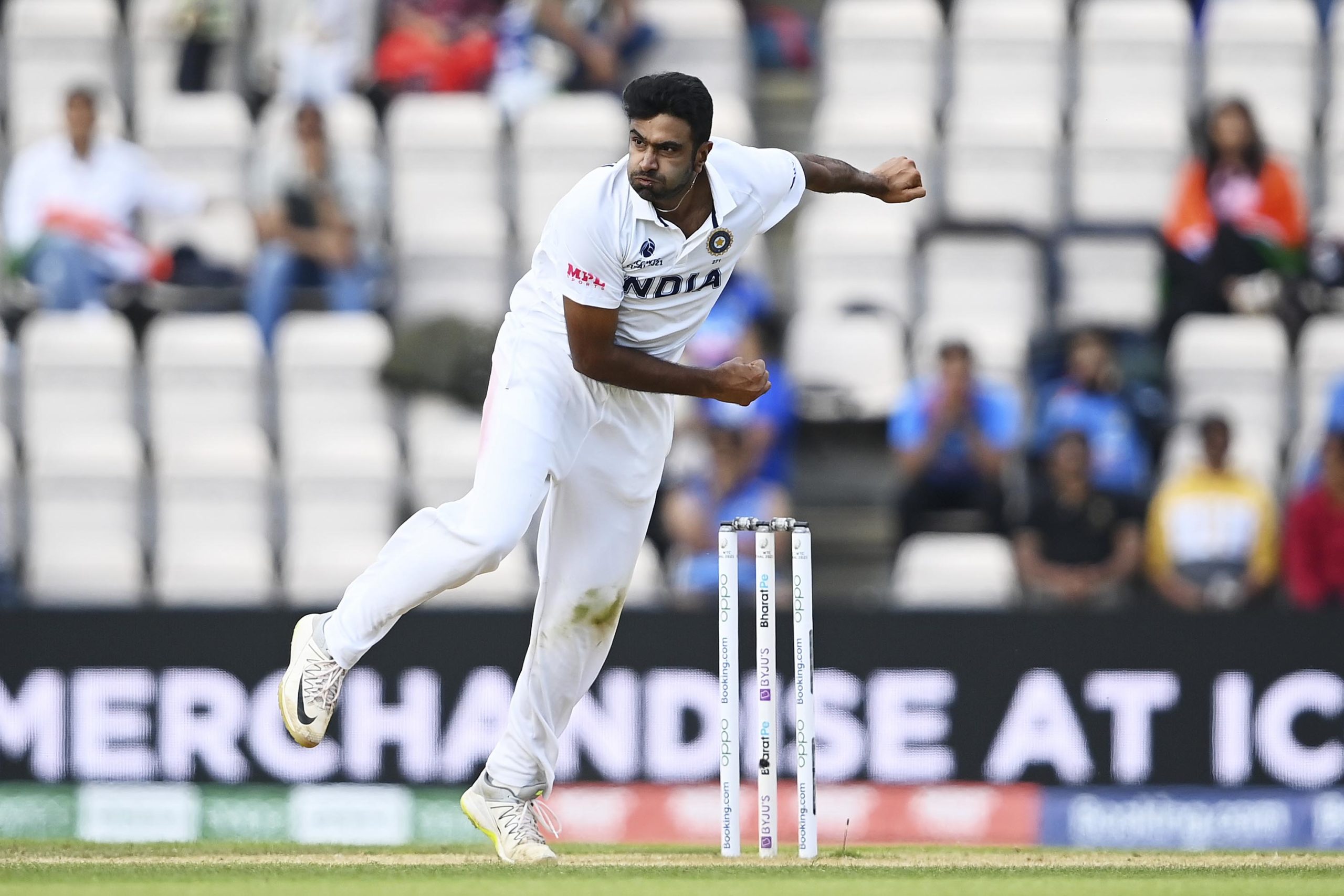Ravichandran Ashwin, cricket’s foremost illusionist
Despite his astounding abilities and a scorecard that reflects them, including 413 Test wickets, the Indian spin bowler has been sidelined by selectors, to the bafflement of fans and commentators a…
Author:
4 December 2021

Ravichandran Ashwin is the latest flower on the long branch of Indian spin bowling. The world’s leading batsmen tip their caps at his sublime gifts. So why do the Indian selectors have such a complicated attitude towards him?
On the world stage he is the new Shane Warne, with the same perfectionism and love of experiment, the same hyper-competitive disposition and the same insatiable hunger for wickets. No less a figure than Steve Waugh once described him as “the Bradman of bowlers”.
The Tamil Nadu right-arm offspinner, whose first name is Sanskrit for “sun and moon conjoined”, has 413 Test victims, trailing only Anil Kumble (619) and Harbhajan Singh (417) in the Indian spin stakes, but outstripping both at the same point in their careers in wickets taken, average and strike rate. He was the fastest Indian to 100, 200, 300 and 400 Test wickets.
Now ranked second in the world, he is way out in front of other spinners. The nearest contenders are Australia’s Nathan Lyon at 20 and Ashwin’s main Indian rival, Ravindra Jadeja, at 21. Yet before he was picked for the ICC T20 World Cup 2021 in a surprise move, he had been sidelined from world white ball cricket for four years. He was left out of the squad for the first three T20 World Cup matches, before thumbing his nose at the selectors with 2/14 in India’s last match against Afghanistan.
Related article:
To screams of protest on social media and the bafflement of the Indian press and English commentators, Ashwin also spent all four Tests of India’s recent tour of England languishing on the bench. He will surely be in Virat Kohli’s squad that will take on the Proteas in three Tests starting on 17 December. But whether, and how often, he will play is not so clear.
South Africa has not been a happy hunting ground for Ashwin, and there is a broader context. Harbhajan has suggested that he is no longer regarded as India’s vanguard spinner.
Yet, English cricketers think the sun shines from Ashwin’s spinning finger. Former skipper Michael Vaughan described his non-selection as “madness”, while ex-opener Nick Compton asked plaintively: “Please can someone explain how [Virat] Kohli’s obvious personal issues with Ashwin are allowed to cloud an obvious selection issue?”
“It is a question on every Indian fan’s mind and lips,” was one Twitter response.
Puzzling selections
It is not that Ashwin lacks form or cannot exploit English conditions: shortly before the first Test he took 6/29 in an English county game. Earlier in the year, when England toured India, he was named Player of the Series for his bowling and batting (something of an allrounder, he scored an important century). It was the eighth time he had been so honoured. The consensus is that the sidelining of Ashwin centrally involved the fiery little bantam cock Kohli, who as captain advises the selection committee.
Quizzed over the inclusion of Jadeja after India’s heavy defeat at Lord’s, Kohli told journalists that England had four left-handed batsmen and that Jadeja, a left-arm finger spinner, could exploit the rough created by the Indian pacemen outside their off stump.
This made absolutely no sense. Ashwin’s off-breaking consistently threatens the left-hander’s outside edge, making him a far tougher proposition. He is, in fact, a specialist assassin of left-handers, his Test dismissals including more than 200 of them. Jadeja was also allegedly favoured because of his superior batting. Puzzlingly promoted up the order to No. 5, he managed 160 runs in the four matches at an average of 23 (and just six wickets at 45 each).
Related article:
Kohli’s characteristic response to pressure from fans and the media is to dig in his heels. And he no doubt views India’s ultimate series victory as a vindication of the selection policy. It was not. If the idea was to pick a spinner to leaven the four-man pace attack, why was Jadeja the preferred option? His limp showing was largely irrelevant to the series win, which was sealed by top-quality fast bowling, notably by Jasprit Bumrah.
Commentator Michael Atherton suggested the motive for Ashwin’s apparent fall from grace lay in India’s traumatic defeat by New Zealand in the ICC World Test Championship final in June. New Zealand’s was an all-seam attack, while India fielded both spinners. That may explain Kohli’s marked preference for seam in the Tests that followed, but it does not account for the dogged faith in Jadeja, who in the final made 15 and 16 and took 1/45 (compared to Ashwin’s 4/45).
Theory and conspiracy
India’s fans and media, who take a uniquely well-informed and opinionated interest in the national sport but also have an appetite for conspiracy, have offered more sinister theories. Some darkly insinuate that Kohli, who is in a form trough and has not scored a Test century since 2019, resents being outshone by his feted spinner.
Is there bad blood? Active on social media, particularly through his widely followed cricket videos on YouTube, Ashwin is known for his outspokenness. Reports surfaced in October that Ashwin had written to his country’s cricket governing body, the Board of Control for Indian Cricket (BCCI), complaining that Kohli’s captaincy made him feel insecure about his place.
Related article:
Ashwin brushed these aside, tweeting: “I’m searching for the handle ‘fake news’. It used to be super-fun for gossip!” Board treasurer Arun Dumal posted a furious denial: “The media must stop writing this rubbish … No Indian cricketer has made any complaint to the BCCI, written or verbal.”
At 35, Ashwin’s age and fitness are credible concerns. But Indian spinners have a long shelf life – Harbhajan still competes in the Indian Premier League at 41. Another factor: the “Turbanator” last played Test cricket six years ago, and for some years before had been in and out of the side as batsmen deciphered him. Ashwin, on the other hand, is an obsessive self-improver who aims to keep himself in contention through incessant tinkering with his bowling technique.
No head can rest easy in India’s cut-throat cricket world, and the pressures start early.
A bag of tricks
Born into a middle-class Brahmin family in Chennai, Ashwin’s childhood, under ambitious parents who drove and superintended his every step, was steeped in the game. His father would wake him at 5.30am to transport him to matches and kept detailed notes on every aspect of his performance, including net practices.
But his chief motivator and coach was his mother Chitra, who encouraged his transition from seam to spin and told an Indian journalist: “When he is batting, I hold the bat.” Lacking Harbhajan’s extraordinarily strong and flexible wrists, Ashwin does not extract his extreme top-spinning bounce and cannot bowl the offspinner’s “wrong ‘un”, the doosra.
But as the world’s foremost cricket illusionist, he has developed 15 other mind-bending variations that Ian Bell, one of England’s best players of spin, calls his “bag of tricks”. The best known is the carrom ball, named after a board game that uses a similar action, which Ashwin says he learnt from playing “gully cricket” with a tennis ball in the streets of Chennai.
A prime example of this was the “T20 ball of the century” – former Test player Adam Gilchrist’s phrase – that skittled Hashim Amla in Dhaka in 2014. Dropping a foot outside leg, it fizzed off the wicket to knock back his off stump.
Related article:
Like the doosra, the carrom looks like an off break but turns the other way. The technique – it is flicked off the thumb and the bent middle finger – was invented by an Australian in the 1950s, but died out of the repertoire until rediscovered by another subcontinental magician, Sri Lanka’s Ajantha Mendis.
Ashwin’s shades of deception confuse even the experts. Interviewed by former England opener and Sky Sports presenter Ian Ward, he was shown, in slow motion, what Ward took to be the carrom ball. The Indian politely corrected him: “It’s more of a backflipper that gives me drift away from the left-hander and into the right-hander,” he explained. “I also go under the seam for it to straighten at times.”
The delivery, he said, took him 24 months to perfect.
Different breaks off the pitch, and their disguise, are only part of the armoury: Ashwin also uses subtle variations of speed, angle, drift (curve through the air) and overspinning dip. Take the two carbon-copy dismissals of Alistair Cook in the same Test match in 2018, the eighth and ninth time he had undone the England opener.
To get Cook playing the wrong line, Ashwin drifts the ball into his pads from round the wicket; it then breaks prodigiously the other way to rattle his stumps. What additionally defeats the Englishman is the sharp dip, which leaves him stranded short of the bounce, unable to smother any deviation.
A brain at work
With an engineering qualification, Ashwin is no chump. He does not replay recordings of his own performances, as some players enjoy doing, but uses video to analyse batsmen. In the middle, one can feel his bowling brain constantly at work.
The dismissal of danger man Steve Smith in Adelaide last December was a clear case of a planned hit, executed with precision. The setup starts with two big-spinning off breaks, to get Smith thinking about the catchers in the leg trap. Ashwin then comes in much closer to the stumps for a straighter line, undercuts the ball so that it skids on, and bowls it appreciably faster. Rushed and playing for a non-existent turn, Smith edges to slip.
As the Ward interview makes clear, every detail of Ashwin’s technique is clinically dissected, from how he cocks his wrist to the depth of the ball in his hand. He has fine-tuned his action to ensure that he is more side-on at the point of release and puts more of his body behind the ball, to transfer energy to the bowling arm and impart higher revs.
It is fascinating to see all the behavioural tweaks this entails: “loading up” behind the shoulders instead of in front of the chest; a stronger back arch to provide “whip”, like a coiled spring; a higher front-leg lift; more front-leg extension for greater pivot…
Perhaps the most commonly voiced criticism of Ashwin’s bowling is that he is a “dust-track bully”, deadly in the subcontinent but relatively ineffectual in the SENA countries (South Africa, England, New Zealand and Australia), where wickets are less responsive to finger spin.
Before his action change, there was substance to this complaint – in 2014, when he was dropped for a Test in Australia, he seemed headed for the scrapheap. Depressed about his future, he asked India’s bowling coach, Bharat Arun, for a technical makeover.
Confounding the critics
The realignment of his body at the crease brought a dramatic improvement. According to Cricinfo analyst Himanish Ganjoo, his average to right-handers after 2015 fell from about 40 to 27. He also started hitting the stumps more often – every 241 balls, instead of every 316.
The new-model Ashwin also put to bed the notion that he cannot bowl away from home. Ganjoo points out that in the SENA countries, he has the best average and economy rate for a specialist spinner and the second-highest wicket tally per innings (2.0).
“The record needs to be set straight,” Ganjoo writes. “Ashwin has been the best a spinner can be in the conditions given to him, in addition to being unbelievably good in Asia.”
Related article:
The last frontier is South Africa, where in three Tests he has managed an unflattering 7/323 overall. But the chronology is important: in 2013, before his makeover, he was plundered by Faf du Plessis and AB de Villiers at the Wanderers, both with centuries.
Five years later, he was more of a handful. In the first innings at Centurion he took a four-for, including the wickets of Dean Elgar, Aiden Markram and Quinton de Kock. In India, on surfaces that sometimes resemble a dried-out riverbed, the South Africans have floundered against him. In the four-week agony of the 2015 tour, he sent 31 batsmen trudging back to the pavilion in seven innings.
Since the beginning of this year, he has been in ominous touch in all Tests, with 48 wickets against England and Australia. Ashwin has a point to prove down south. If he plays, Dean Elgar and his merry men had better be on their mettle.





